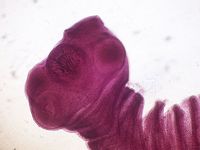Difference between revisions of "Taenia solium"
(→Hosts) |
|||
| Line 26: | Line 26: | ||
==Life Cycle== | ==Life Cycle== | ||
| − | The life-cycle is similar to that of [[Taenia saginata|''T. saginata'']], except now the pig is the intermediate host. Gravid segments, containing the parasite eggs are passed in faeces. The oncospheres are then ingested by the intermediate host, in this case the pig, and pass into the blood system, infecting striated muscles. The cysticerci may also develop in the | + | The life-cycle is similar to that of [[Taenia saginata|''T. saginata'']], except now the pig is the intermediate host. Gravid segments, containing the parasite eggs are passed in faeces. The oncospheres are then ingested by the intermediate host, in this case the pig, and pass into the blood system, infecting striated muscles. The cysticerci may also develop in the lungs, liver, kidney and the brain. Like ''T. saginata'', humans, which are the definitive hosts, become infected via ingestion of poorly cooked meat containing viable cysticerci. |
| + | Contrary to ''T. saginata'', humans can also act as intermediate host. Cysticerci can develop in several tissues, including the central nervous system, causing neurocysticercosis in man. | ||
==Test yourself with the Cestode Flashcards== | ==Test yourself with the Cestode Flashcards== | ||
Revision as of 11:38, 6 March 2012
| This article has been peer reviewed but is awaiting expert review. If you would like to help with this, please see more information about expert reviewing. |
| Taenia solium | |
|---|---|
| Kingdom | Animalia |
| Phylum | Platyhelminthes |
| Class | Cestoda |
| Order | Cyclophyllidea |
| Family | Taeniidae |
| Genus | Taenia |
| Species | T. solium |
Also known as: Cysticercus cellulosae — Human pork tapeworm
Hosts
Intermediate host: Pig (natural intermediate host), man (accidental intermediate host) and very exceptionally the dog.
Definitive host: Man.
Identification
The adults are 3-5m in length, have a scolex, and several rows of hooks.
Life Cycle
The life-cycle is similar to that of T. saginata, except now the pig is the intermediate host. Gravid segments, containing the parasite eggs are passed in faeces. The oncospheres are then ingested by the intermediate host, in this case the pig, and pass into the blood system, infecting striated muscles. The cysticerci may also develop in the lungs, liver, kidney and the brain. Like T. saginata, humans, which are the definitive hosts, become infected via ingestion of poorly cooked meat containing viable cysticerci. Contrary to T. saginata, humans can also act as intermediate host. Cysticerci can develop in several tissues, including the central nervous system, causing neurocysticercosis in man.
Test yourself with the Cestode Flashcards
Literature Search
Use these links to find recent scientific publications via CAB Abstracts (log in required unless accessing from a subscribing organisation).
Taenia solium publications since 2000
References
Taylor, M.A, Coop, R.L., Wall,R.L. (2007) Veterinary Parasitology Blackwell Publishing

